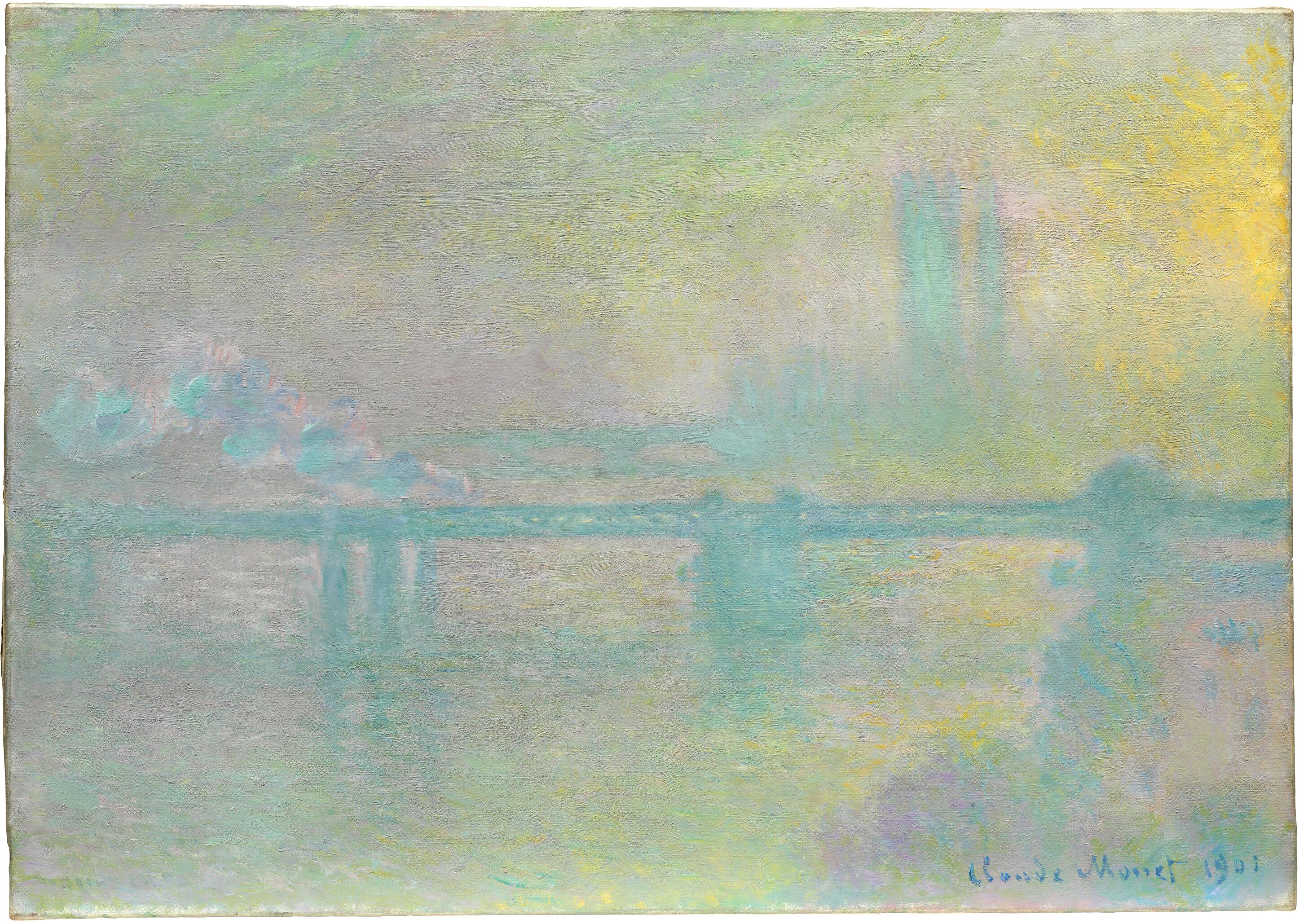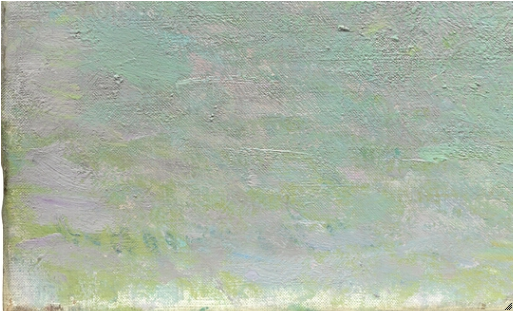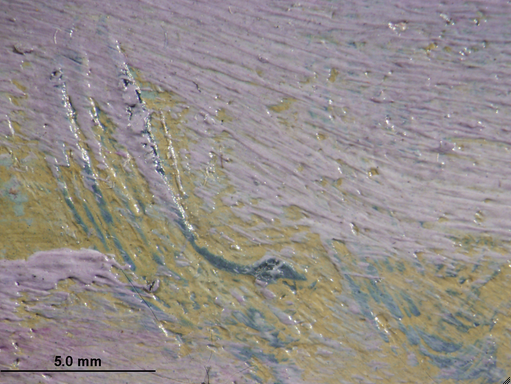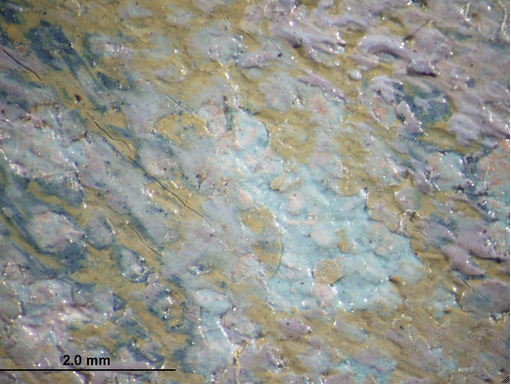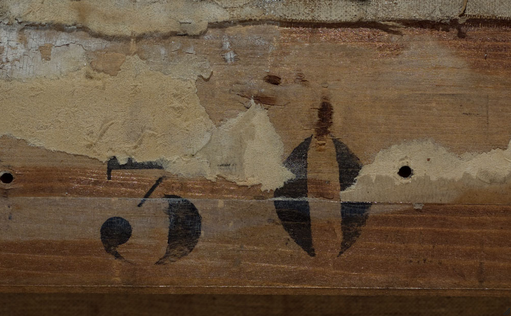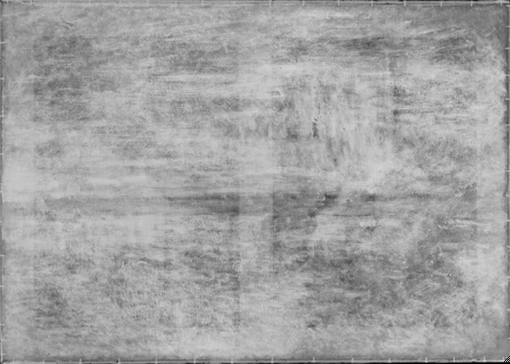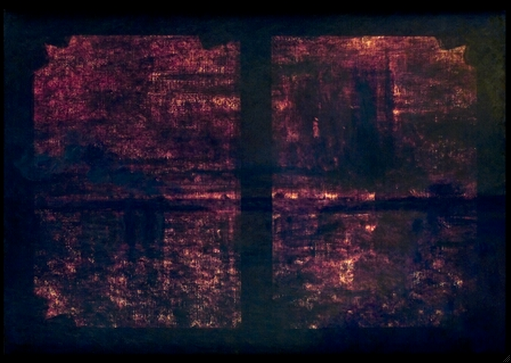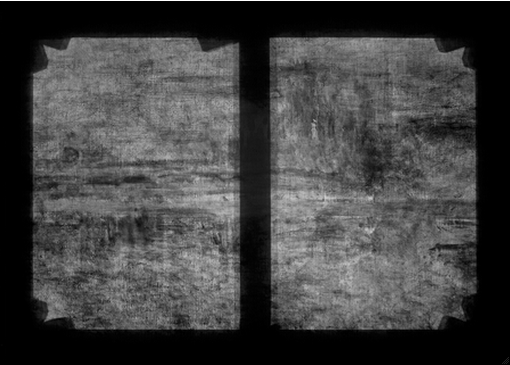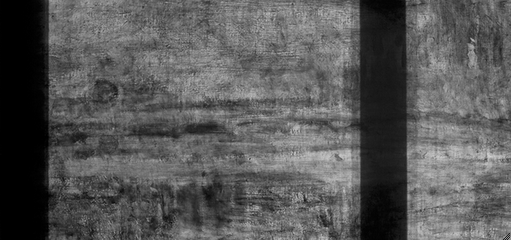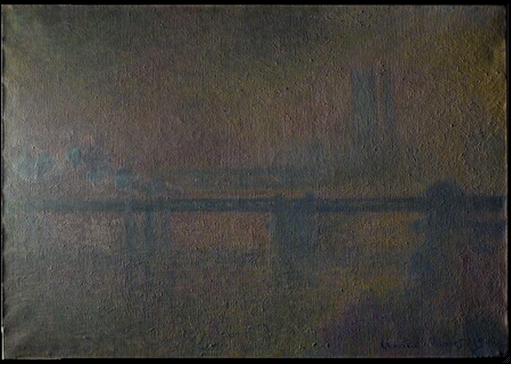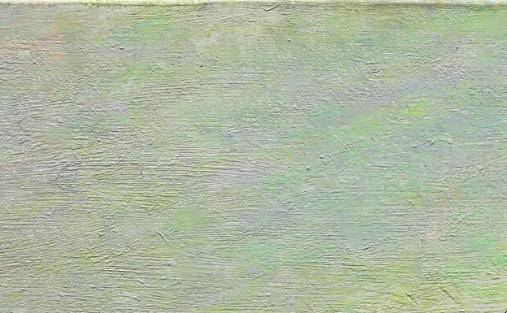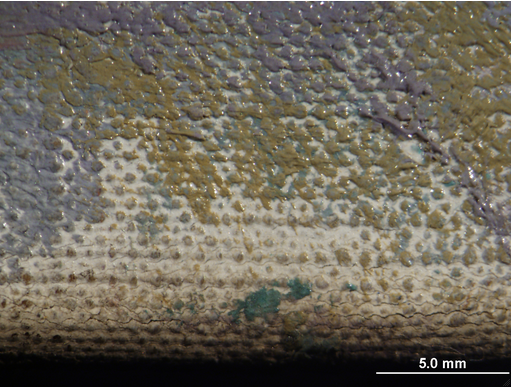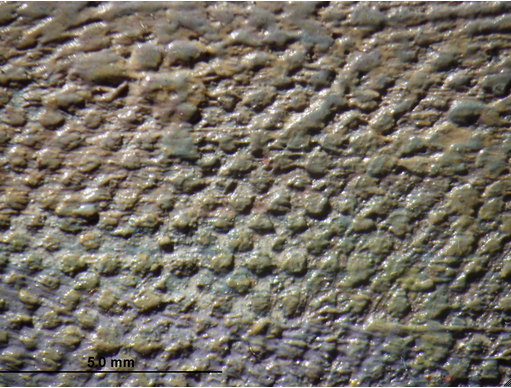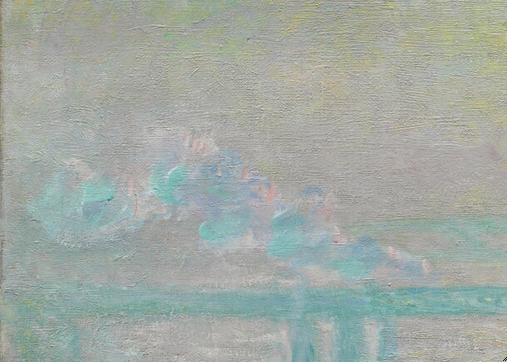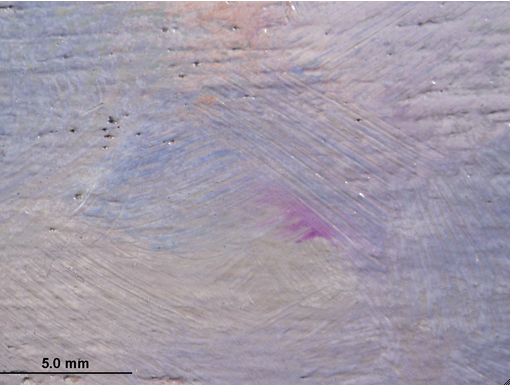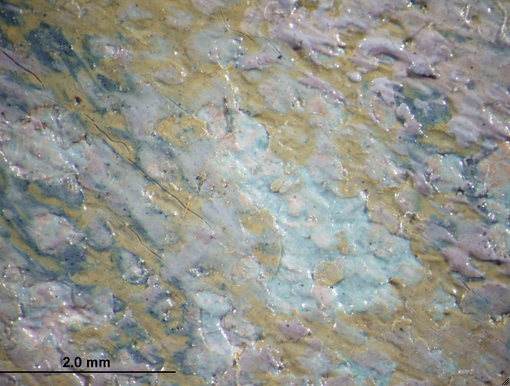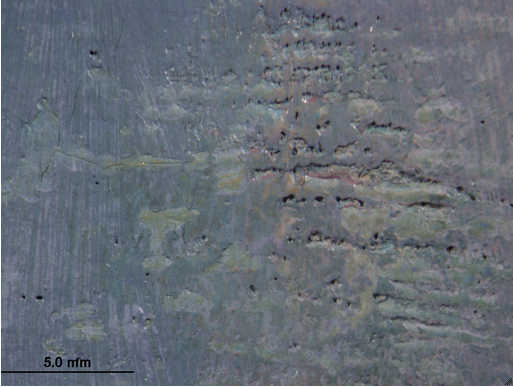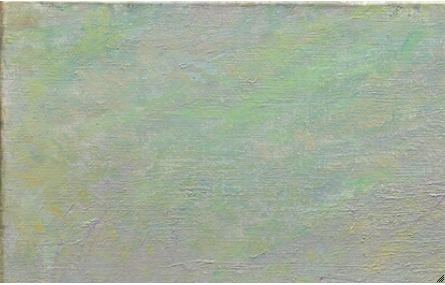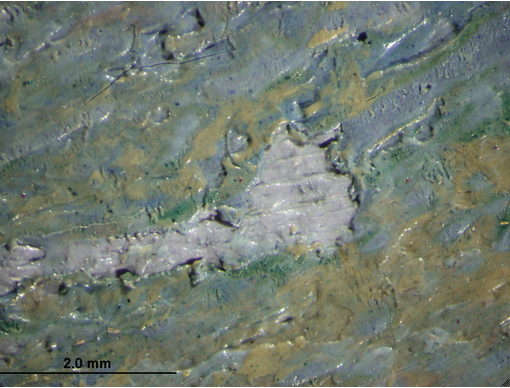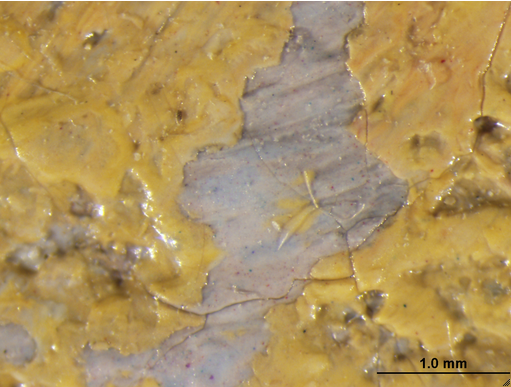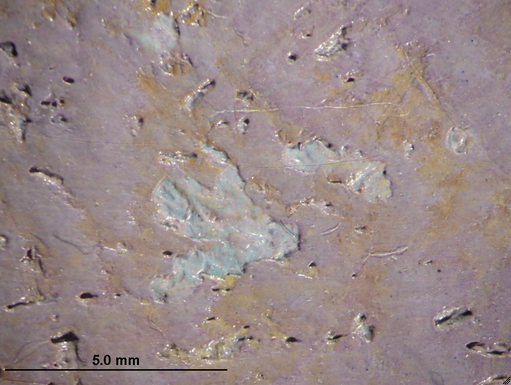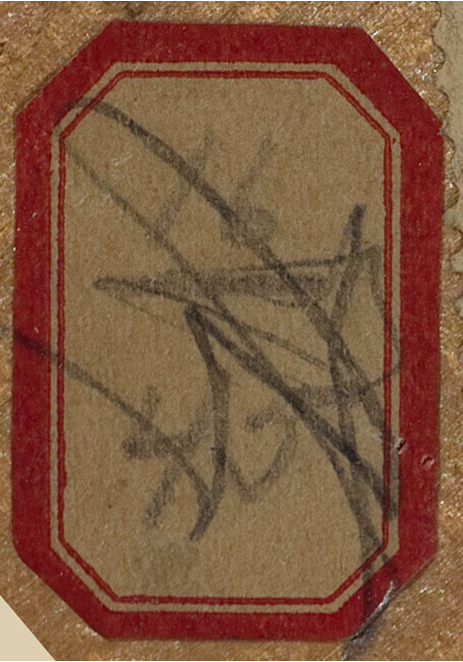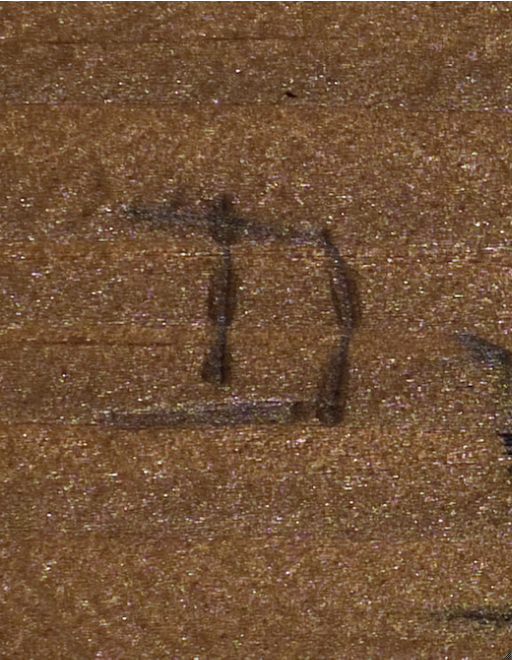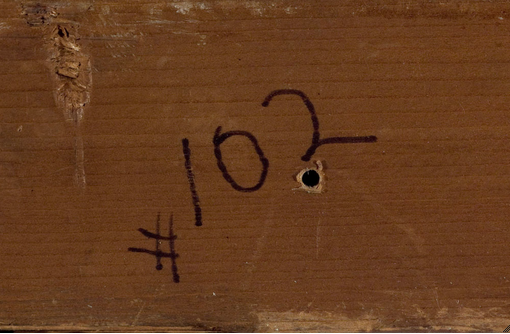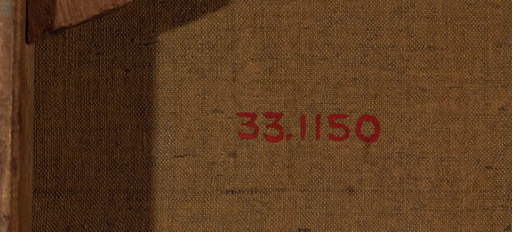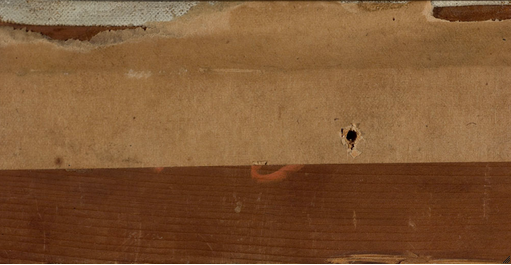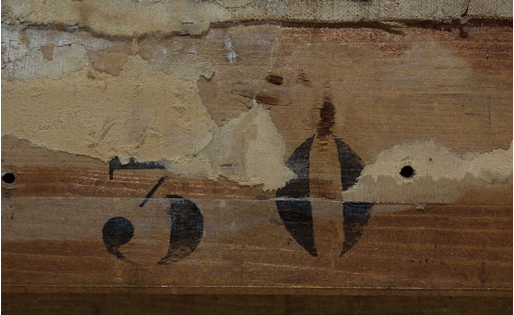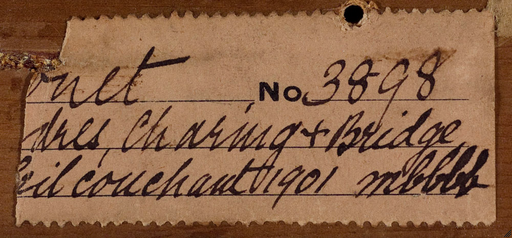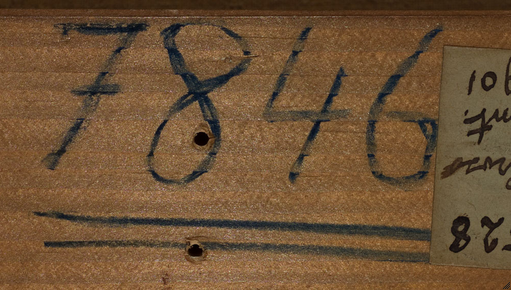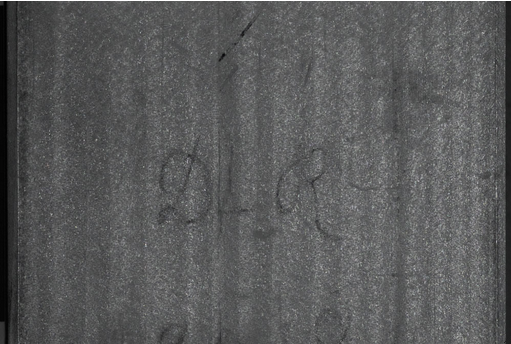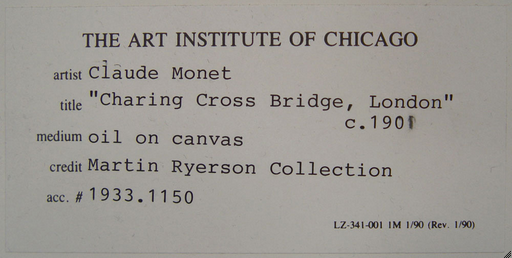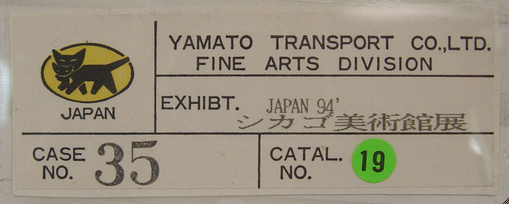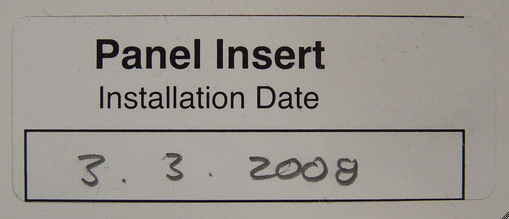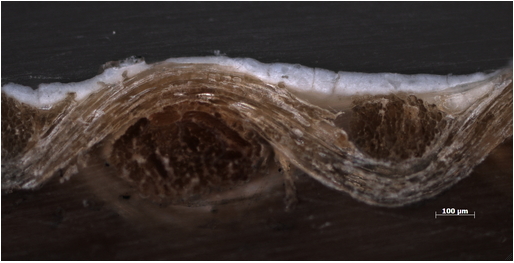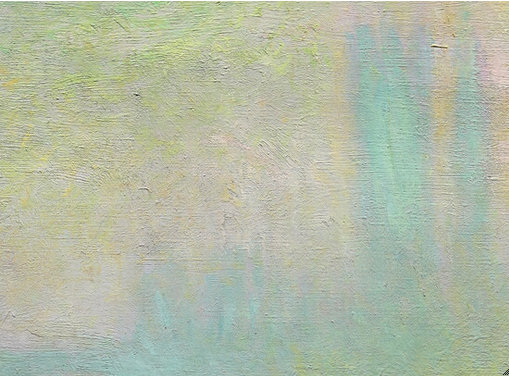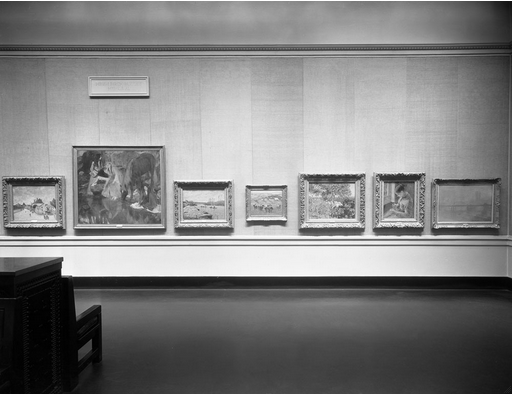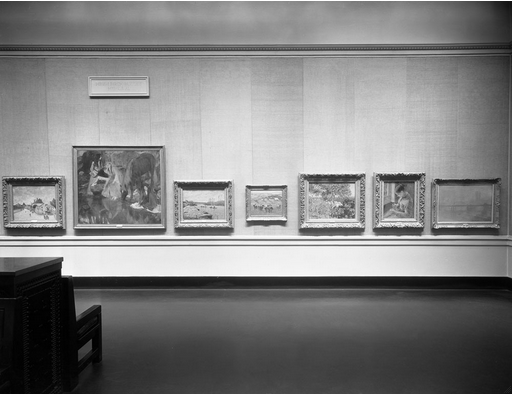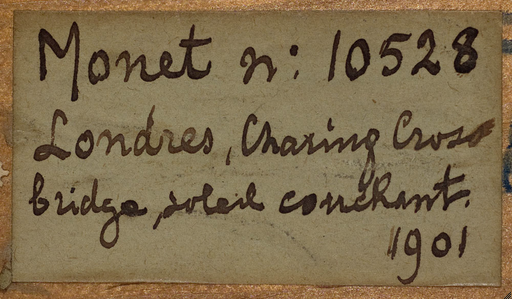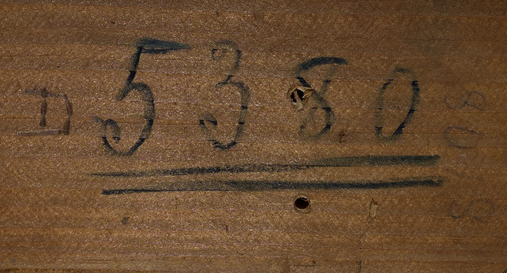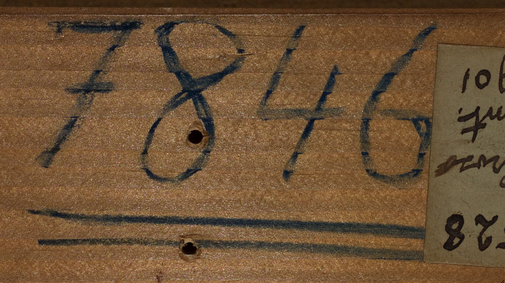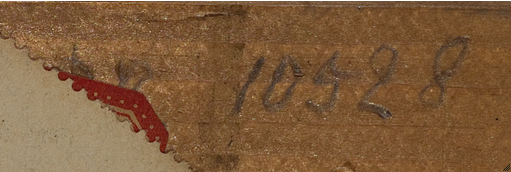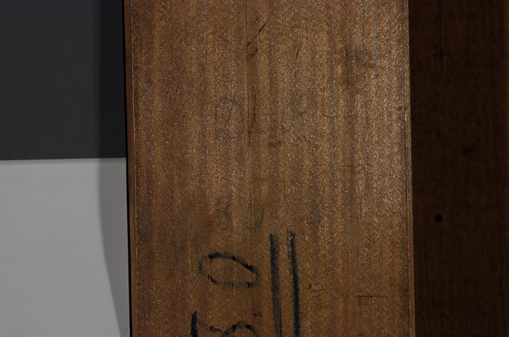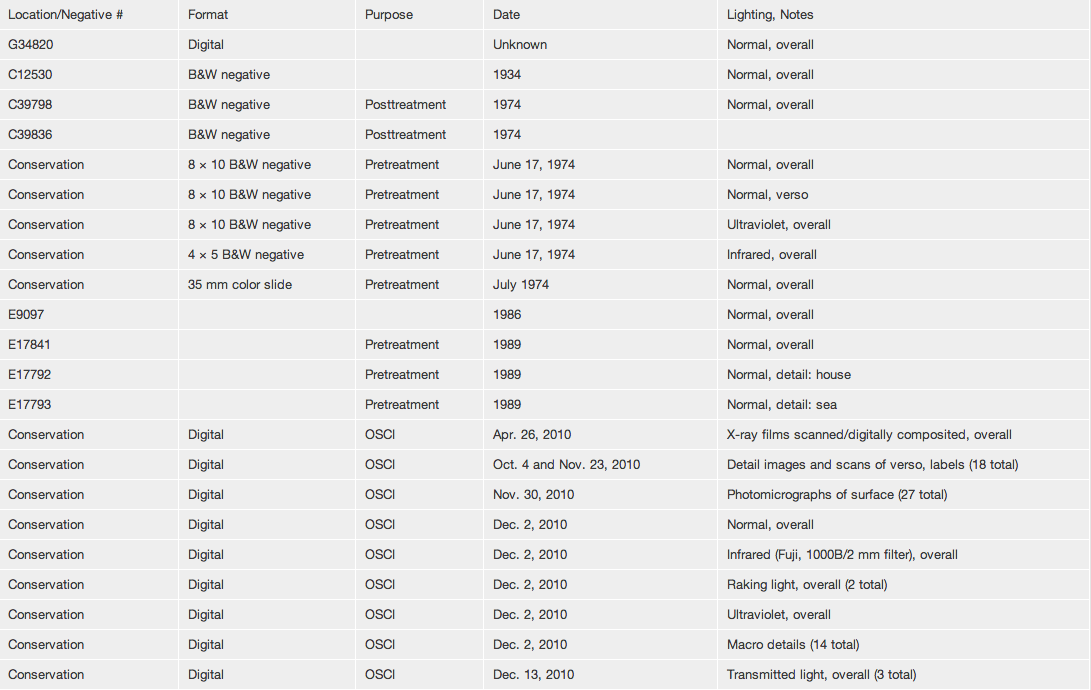Cat. 40
Charing Cross Bridge, London
1901
Oil on canvas 65 × 92.2 cm (25 5/8 × 36 5/16 in.)
Signed and dated: Claude Monet 1901 (lower right, in blue paint)
The Art Institute of Chicago, Mr. and Mrs. Martin A. Ryerson Collection, 1933.1150
Technical Report
Technical Summary
Claude Monet’s Charing Cross Bridge, London was executed on a pre-primed, no. 30 landscape (paysage) standard-size linen canvas. The painting appears to retain its original stretcher. The number 30 stenciled on the back of the stretcher probably refers to the stretcher size. The ground is off-white and consists of a single layer. A warp-thread match was determined with two other paintings in the Art Institute’s collection: Stack of Wheat (Snow Effect, Overcast Day) (cat. 30 [W1281], inv. 1933.1155) and The Customs House at Varengeville (cat. 35 [W1455], inv. 1933.1149), suggesting that the fabric for these paintings came from the same bolt of fabric. The painting has a heavily brush marked surface. Crisp brushstrokes introduced in the earlier paint layers remain visible on the surface through the thin, fluid brushstrokes applied on top. In some places, the canvas texture remains prominent through light applications of paint that deposited mainly on the peaks of the canvas weave. The artist also appears to have scraped or wiped the upper paint layers in localized areas, revealing colors from underneath. In some places, small areas of interlayer cleavage have resulted, due to poor adhesion between the layers. The artist made a significant change in the perspective of the scene. The technical examination shows that major compositional elements, including the bridge supports, the bridge house, the embankment, and the buildings were all originally painted further left of their positions in the final painting. In addition, more of Westminster Bridge, in the distance, was originally included, its arches initially extending further to the left edge of the canvas. The painting was originally signed at the lower left corner. This signature was then painted over, probably in conjunction with further reworking of the painting, and then signed again in the lower-right corner.
Multilayer Interactive Image Viewer
The multilayer interactive image viewer is designed to facilitate the viewer’s exploration and comparison of the technical images (fig. 40.1).
Signature
Signed and dated: Claude Monet 1901 (lower right, in blue paint) (fig. 40.2). Some of the strokes of pale-pinkish-purple paint were still wet when the signature was applied. These strokes may represent finishing touches added by the artist before signing the painting.
At the lower left corner, there are traces of another signature that was subsequently painted over (fig. 40.3). This signature was also executed in blue paint (fig. 40.4). It is difficult to make out the second half of the signature, which may indicate that the paint was at least partially scraped or wiped away before subsequent paint layers were applied. It is not clear whether the painting was also dated in this area, but microscopic traces of similar blue paint extend sufficiently far to the right to suggest this possibility. It looks like the signature was dry when the yellowish-green paint from the water was applied on top. It is clear that some wiping or scraping of the paint surface, similar to that observed elsewhere in the painting (see Application/technique), occurred after the signature was painted out. The paint appears flattened and abraded in areas, with underlying layers exposed at the surface. There are small, localized areas of associated interlayer cleavage where separation has occurred between the upper, yellowish-green paint and the lower paint layers including the signature (fig. 40.5). The pale-pink and pale-purple strokes of the water were applied after the abrasion and interlayer cleavage had occurred.
Structure and Technique
Support
Canvas
Flax (commonly known as linen).
Standard format
The dimensions correspond closely to a no. 30 landscape (paysage) standard-size stretcher (65 × 92 cm).
Weave
Plain weave. Average thread count (standard deviation): 23.4V (0.6) × 20.9H (0.7) threads/cm; the vertical threads were determined to correspond to the warp and the horizontal threads to the weft. A warp-thread match was found with Stack of Wheat (Snow Effect, Overcast Day) (cat. 30 [W1281], inv. 1933.1155) and The Customs House at Varengeville (cat. 35 [W1455], inv. 1933.1149).
Canvas characteristics
There is mild cusping along the top and bottom edges of the canvas, moderate cusping on the left edge, and more pronounced and irregular cusping along the right edge.
Stretching
The painting appears to retain its original stretching. The canvas is attached with iron tacks spaced 5.5–7.5 cm apart. The cusping corresponds to the placement of the original tacks. There are a few additional small holes on each tacking edge, which appear to be more recent. Excess canvas wraps around the back edge of the stretcher on all sides.
Stretcher/strainer
The painting appears to retain its original stretcher (fig. 40.6). It is five membered with a vertical crossbar and keyable, mortise and tenon joints. All ten keys are present (lower crossbar key broken but still functional). Dimensions: outer depth, 2.0 cm; inner depth, 1.8 cm; stretcher-bar width, 6.0 cm (left, right, and bottom), 6.4 cm (top); crossbar depth, 1.3 cm; crossbar width, 6.2 cm.
Manufacturer’s/supplier’s marks
The number 30 is stenciled on the back of the stretcher (fig. 40.7). This probably refers to the standard-size stretcher.
Preparatory Layers
Sizing
Not determined (probably glue).
Ground application/texture
The ground layer extends to the edges of all four tacking margins, indicating that the canvas was cut from a larger piece of primed fabric, which was probably commercially prepared. Cross-sectional analysis indicates that the ground consists of a single layer that ranges from approximately 20 to 105 µm in thickness (fig. 40.8).
Color
The ground is off-white, with some dark and possibly red or brown particles visible under magnification (fig. 40.9).
Materials/composition
Analysis indicates that the ground contains lead white and calcium carbonate (chalk) with traces of alumina, silica, and various silicates. Binder: Oil (estimated).
Compositional Planning/Underdrawing/Painted Sketch
Extent/character
No underdrawing was observed with infrared reflectography (IRR) or microscopic examination.
Paint Layer
Application/technique and artist’s revisions
The painting was densely built up over most of the surface, as evidenced by the relative radio-opacity of much of the paint layer in the X-ray (fig. 40.10). The paint layers are continuous, completely concealing the ground layer, except near the edges of the work. The thick buildup of paint is partly related to the fact that the artist made significant changes to the placement of the major compositional elements. The vertical supports of Charing Cross Bridge, as well as the bridge house, the embankment in the lower right corner, and the towers of the Houses of Parliament were all originally painted to the immediate left of their final positions. The outlines of the earlier forms are most clearly seen when the painting is viewed in transmitted light (fig. 40.11). With the use of transmitted infrared, the horizontal line of the railroad tracks can be seen to continue straight across to the right edge of the canvas, underneath the bridge house in the final painting (fig. 40.12). In addition, the perspective of Westminster Bridge, faintly visible in the distance, was also altered slightly: the arches painted in the earlier composition are offset from their position in the final painting; and, in the earlier painting, five or six arches were depicted, continuing further to the left edge of the painting, underneath the area later covered by the steam from the train (fig. 40.13). These changes suggest that the artist shifted his viewpoint of the scene and that the steam train on Charing Cross Bridge may not have been conceived for the first composition or, at least, was not incorporated early in the painting process.
Overall, the painting is relatively flat with no impasto. It does, however, have a heavily brush marked surface (fig. 40.14). Much of this texture was introduced in the early painting stages; for example, the crisp horizontal strokes that run through broad areas of the sky (fig. 40.15) and the crisscrossed strokes in the water (fig. 40.16), the texture of which remain evident through the subsequent buildup of paint layers applied on top. These underlying strokes appear to be related to the earlier composition, as they seem to conform to the edges of the painted-out forms. For example, the horizontal brush marks in the sky, which pass underneath the towers of the Parliament buildings in the final painting, seem to stop on either side of the earlier towers that were painted out (fig. 40.17). Further texture was incorporated into the paint surface through the artist’s use of different paint applications and treatments. For example, a corrugated texture was created in some areas through the successive buildup of paint layers that were lightly applied and deposited mainly on the high points of the canvas weave (fig. 40.18, fig. 40.19). In some areas, slightly thicker and more fluid paint applications provide a relatively smooth, flat surface, obscuring much of the texture of the layers underneath (fig. 40.20). In localized areas, including the steam from the train, the fluid paint was worked wet-into-wet (fig. 40.21, fig. 40.22). In other areas, the artist appears to have lightly scraped or wiped the upper layers, breaking up the paint surface by locally revealing colors from underlying layers (fig. 40.23, fig. 40.24). This is especially visible in parts of the sky, where the abrasion reveals the peaks of the lighter-hued, horizontal brushstrokes from underneath (fig. 40.25, fig. 40.26). Often, in association with the scraping or wiping, some interlayer cleavage has occurred (fig. 40.27). For the most part, the underlying paint looks like it was already dry when it was painted over, as the ridges of the brush marks remained undisturbed. This probably resulted in weak adhesion between the layers, leading to separation when the artist worked back into the surface (fig. 40.28). The edges of the interlayer cleavage losses appear soft, suggesting that the upper paint layers were still somewhat fluid when the cleavage occurred (fig. 40.29). Some final paint strokes were applied over these localized areas of interlayer cleavage, including parts of the final signature, and the isolated purple strokes that skip across the surface of the sky. There are several small inclusions (possibly dried paint picked up on the brush) embedded in the paint layer.
Painting tools
Brushes, including 1.0 and 2.0 cm width, flat ferrule (based on width and shape of brushstrokes). Several brush hairs are embedded in the paint layers.
Palette
Analysis indicates the presence of the following pigments: lead white, cadmium yellow, vermilion, red lake, emerald green, viridian, cobalt blue, ultramarine blue, and cobalt violet.
Binding media
Oil (estimated).
Surface Finish
Varnish layer/media
The painting was cleaned in 1993 and left unvarnished (see Conservation History). It has a soft yet variable surface, with relatively matte passages as well as areas of smooth, fluid paint application that have a slightly glossy sheen. In 1971, the painting was reported to have a discolored and yellowed, soft resin varnish layer; its origin is unknown.
Conservation History
The 1972 pretreatment notes state that there were scattered abrasions, especially in the left sky and foreground, which had previously been overpainted. There is some evidence of this in the 1971 pretreatment UV photograph in the sky at upper left, but more apparent is the minor inpainting visible in the sky, right of center and at the upper right edge. All of this retouching appears to be related to the interlayer cleavage resulting from the artist’s technique of scraping or wiping the paint surface (see Application/technique).
In 1972, discolored surface films and overpaint were removed. A layer of polyvinyl acetate (PVA) AYAA was applied. Paint losses were inpainted. A layer of methacrylate resin L-46 was applied, followed by a final layer of AYAA.
In 1991, the synthetic varnish layers and previous retouching were removed. Three small interlayer cleavage losses in the sky at upper left were inpainted.
Condition Summary
The painting is in near-pristine condition. It is unlined and appears to retain its original stretcher and tacking. The canvas is stretched taut and is relatively planar, except for mild draws at the upper left, lower left, and lower right corners. The paint layer is in excellent condition. Small areas of interlayer cleavage throughout the painting appear to be related to the artist’s technique (i.e., possible scraping) (see Application/technique). There is mild abrasion in the ground and paint layers at the edges, with minor, associated retouching along the left edge. Other areas of retouching—in the sky at upper left and near the lower left corner—appear to be related to the interlayer cleavage losses. There are localized areas of fine cracking, which are only visible under magnification. A few localized areas of microscopic wrinkling were observed in areas of more-fluid paint application. The painting is currently unvarnished.
Kimberley Muir
Frame
The current frame appears to be original to the painting. It is a French (Parisian), early-twentieth-century, Durand-Ruel, Régence Revival, ogee frame with cast foliate and center cartouches with cabochon centers on a quadrillage bed, leaf-tip-and-shell sight molding and a nonoriginal independent fillet liner. The frame has both water and oil gilding. The liner has been painted gold. Red bole was used on the perimeter molding, the cast foliate on the ogee and sight molding, and the scotia sides. Red-orange bole was used on the sanded frieze and bordering fillets. No bole was applied to the quadrillage bed of the ogee face. The ornament and sight molding are selectively burnished. The frame has an overall light brass tone with an even toning wash, on top of which casein or gouache raw umber and gray washes and dark flecking were applied. The frame has a glued poplar substrate that is mitered and nailed with glued half-lap braces with a cast plaster face. At a later date the original back of the frame was planed flat, removing all construction history and provenance. A back frame was then glued to the back and all back and interior surfaces were painted. The molding, from perimeter to interior, is fillet with stylized, running undulating bands with rhomboid center punches; scotia side; ogee face with a cast quadrillage bed and center and corner foliate and floral cartouches with cabochon centers on a double-lined diamond bed with punched centers; fillet; sanded front frieze; fillet; ogee with stylized leaf-tip-and-shell sight molding; and an independent fillet liner with cove sight (fig. 40.30, fig. 40.31).
Kirk Vuillemot
Provenance
Sold by the artist to Durand-Ruel, Paris, Oct. 30, 1905, for 8,000 francs.
Sold by Durand-Ruel, Paris, to Adrien Hébrard, as agent for the Prince de Wagram (Alexandre Berthier, 4th Prince de Wagram), Paris, Dec. 20, 1905, for 15,000 francs.
Sold by the Prince de Wagram (Alexandre Berthier, 4th Prince de Wagram), Paris, to Durand-Ruel, Paris, Apr. 4, 1914, for 15,000 francs.
Sold by Durand-Ruel, Paris, to Durand-Ruel, New York, Nov. 11 or Dec. 9, 1915.
Sold by Durand-Ruel, New York, to Martin A. Ryerson, Chicago, Feb. 23, 1916, for a painting by Pierre-Auguste Renoir [Pivoines, no. 3094], plus $1,000.
Bequeathed by Martin A. Ryerson (died 1932), Chicago, to the Art Institute of Chicago, 1933.
Exhibition History
University of Chicago, Classics Building, The Quarter-Centennial Celebration of the University of Chicago, Paintings of the French Impressionist School, June 21–Sept. 1, 1916, no cat.
Art Institute of Chicago, “A Century of Progress”: Loan Exhibition of Paintings and Sculpture, May 23–Nov. 1, 1933, cat. 294. (fig. 40.32)
Art Institute of Chicago, “A Century of Progress”: Loan Exhibition of Paintings and Sculpture for 1934, June 1–Oct. 31, 1934, cat. 212.
Art Institute of Chicago, The Paintings of Claude Monet, Apr. 1–June 15, 1957, no cat. no.
Art Institute of Chicago, Paintings by Monet, Mar. 15–May 11, 1975, cat. 102 (ill.).
Tokyo, Seibu Museum of Art, Shikago bijutsukan insho-ha ten [The Impressionist tradition: Masterpieces from the Art Institute of Chicago], Oct. 18–Dec. 17, 1985, cat. 63 (ill.); Fukuoka Art Museum, Jan. 5–Feb. 2, 1986; Kyoto Municipal Museum of Art, Mar. 4–Apr. 13, 1986.
Nagaoka, Niigata Prefectural Museum of Modern Art, Shikago bijutsukan ten: Kindai kaiga no 100-nen [Masterworks of modern art from the Art Institute of Chicago], Apr. 20–May 29, 1994, cat. 19 (ill.); Nagoya, Aichi Prefectural Museum of Art, June 10–July 24, 1994; Yokohama Museum of Art, Aug. 6–Sept. 25, 1994.
Fort Worth, Tex., Kimbell Art Museum, The Impressionists: Master Paintings from the Art Institute of Chicago, June 29–Nov. 2, 2008, cat. 85 (ill.).
Selected References
M. C., “Monets in the Art Institute,” Bulletin of the Art Institute of Chicago 19, 2 (Feb. 1925), pp. 20 (ill.), 21.
Art Institute of Chicago, Catalogue of “A Century of Progress”: Exhibition of Paintings and Sculpture; Lent from American Collections, ed. Daniel Catton Rich, 3rd ed., exh. cat. (Art Institute of Chicago, 1933), p. 43, cat. 294.
Daniel Catton Rich, “Französische Impressionisten im Art Institute zu Chicago,” Pantheon: Monatsschrift für freunde und sammler der kunst 11, 3 (Mar. 1933), p. 77. Translated by C. C. H. Drechsel as “French Impressionists in the Art Institute of Chicago,” Pantheon/Cicerone (Mar. 1933), p. 18.
Art Institute of Chicago, Catalogue of “A Century of Progress”: Exhibition of Paintings and Sculpture, 1934, ed. Daniel Catton Rich, exh. cat. (Art Institute of Chicago, 1934), p. 37, cat. 212.
Oscar Reuterswärd, Monet: En konstnärshistorik (Bonniers, 1948), p. 287.
Art Institute of Chicago, “Catalogue,” Art Institute of Chicago Quarterly 51, 2 (Apr. 1, 1957), p. 34.
William C. Seitz, Claude Monet, Library of Great Painters (Abrams, 1960), p. 40, fig. 52.
Art Institute of Chicago, Paintings in the Art Institute of Chicago: A Catalogue of the Picture Collection (Art Institute of Chicago, 1961), p. 321.
Grace Seiberling, “The Evolution of an Impressionist,” in Paintings by Monet, ed. Susan Wise, exh. cat. (Art Institute of Chicago, 1975), p. 36.
Susan Wise, ed., Paintings by Monet, exh. cat. (Art Institute of Chicago, 1975), p.159, cat. 102 (ill.).
A. James Speyer and Courtney Graham Donnell, Twentieth-Century European Paintings (University of Chicago Press, 1980), p. 58, cat. 3A9; microfiche 3, no. 3A9 (ill.).
Grace Seiberling, Monet’s Series (Garland, 1981), p. 370, no. 3.
Art Institute of Chicago, Seibu Museum of Art, Kyoto Municipal Museum of Art, and Fukuoka Art Museum, Shikago bijutsukan insho-ha ten [The Impressionist tradition: Masterpieces from the Art Institute of Chicago], exh. cat. (Nippon Television Network, 1985), pp. 124, cat. 63 (ill.); 125 (detail); 160–61 (ill.).
Daniel Wildenstein, Claude Monet: Biographie et catalogue raisonné, vol. 4, Peintures, 1899–1926 (Bibliothèque des Arts, 1985), pp. 160; 161, cat. 1527 (ill.); 431, pièce justificative 275.
Richard R. Brettell, Post-Impressionists (Art Institute of Chicago/Abrams, 1987), pp. 91, 93 (ill.), 118.
Grace Seiberling, Monet in London, exh. cat. (High Museum of Art/University of Washington Press, 1988), pp. 49; 78, fig. 59.
Art Institute of Chicago and Niigata Prefectural Museum of Modern Art, Shikago bijutsukan ten: Kindai kaiga no 100-nen [Masterworks of modern art from the Art Institute of Chicago], exh. cat. (Asahi Shinbunsha, 1994), pp. 80–81, cat. 19 (ill.).
Eric Shanes, Impressionist London (Abbeville, 1994), pp. 125, pl. 101; 127.
Charles F. Stuckey, “Chicago’s Fortune: Patrons of Modern Paintings and The Art Institute of Chicago,” in Art Institute of Chicago and Niigata Prefectural Museum of Modern Art, Shikago bijutsukan ten: Kindai kaiga no 100-nen [Masterworks of modern art from the Art Institute of Chicago], exh. cat. (Asahi Shinbunsha, 1994), p. 18.
Andrew Forge, Monet, Artists in Focus (Art Institute of Chicago, 1995), pp. 56; 57; 65; 100, pl. 29; 109.
Daniel Wildenstein, Monet: Catalogue raisonné/Werkverzeichnis, vol. 3, Nos. 969–1595 (Taschen/Wildenstein Institute, 1996), pp. 655–56, cat. 1527 (ill.).
Art Institute of Chicago, Impressionism and Post-Impressionism in the Art Institute of Chicago, selected by James N. Wood (Art Institute of Chicago/Hudson Hills, 2000), p. 157 (ill.).
Ann Sumner, with contributions by Louisa Briggs and Julia Carver, Colour and Light: Fifty Impressionist and Post-Impressionist Works at the National Museum of Wales (National Museum of Wales, 2005), pp. 20 (ill.), 90 (ill.), 91.
John E. Thornes and Gemma Metherell, “The Art and Science of London’s Atmosphere around 1900,” in London’s Environment: Prospects for a Sustainable City, ed. Julian Hunt (Imperial College Press, 2005), p. 119.
Gloria Groom and Douglas Druick, with the assistance of Dorota Chudzicka and Jill Shaw, The Impressionists: Master Paintings from the Art Institute of Chicago, exh. cat. (Art Institute of Chicago/Kimbell Art Museum, 2008), pp. 166–67, cat. 85 (ill.). Simultaneously published as Gloria Groom and Douglas Druick, with the assistance of Dorota Chudzicka and Jill Shaw, The Age of Impressionism at the Art Institute of Chicago (Art Institute of Chicago/Yale University Press, 2008), pp. 166–67, cat. 85 (ill.).
Other Documentation
Documentation from the Durand-Ruel Archives
Inventory number
Stock Durand-Ruel Paris 8018, Paris Stock Book 1901–13
Photograph number
Photo Durand-Ruel Paris 5380
Inventory number
Stock Durand-Ruel Paris 10528, Paris Stock Book 1913–21
Photograph number
Photo Durand-Ruel Paris 7846
Inventory number
Stock Durand-Ruel New York 3898, New York Stock Book 1904–24
Other Documents
Label (fig. 40.33)
Label (fig. 40.34)
Inscription (fig. 40.35)
Inscription (fig. 40.36)
Inscription (fig. 40.37)
Inscription (fig. 40.38)
Purchase receipt
Labels and Inscriptions
Undated
Label
Location: stretcher
Method: printed label with handwritten script
Content: A. I. / 2 / 9[?] (fig. 40.39)
Label
Location: stretcher
Method: obscured by label applied on top, but label has printed red border
Content: [?] (fig. 40.40)
Label
Location: stretcher
Method: handwritten script on printed label
Content: 16 / 45 [crossed out] (fig. 40.41)
Stamp
Location: stretcher
Method: ink stamp
Content: 30 / M / M / M[?] (fig. 40.42)
Inscription
Location: stretcher
Method: handwritten script
Content: D (fig. 40.43)
Number
Location: stretcher
Method: handwritten script
Content: #102 (fig. 40.44)
Number
Location: canvas
Method: handwritten script
Content: 33.1150 (fig. 40.45)
Possible inscription or number
Location: stretcher
Method: handwritten script
Content: [covered by paper] (fig. 40.46)
Pre-1980
Stamp
Location: stretcher
Method: stencil
Content: 30 (fig. 40.47)
Label
Location: stretcher
Method: printed label with handwritten script
Content: [M]onet No 3898 / [. . .]dres, Charing+Bridge / [. . .]leil couchant 1901 mbbbb (fig. 40.48)
Label
Location: stretcher
Method: handwritten script
Content: Monet no. 10528 / Londres, Charing Cross / bridge, soleil couchant. / 1901 (fig. 40.49)
Number
Location: stretcher
Method: handwritten script
Content: [DR?] 10528 (Mon CharX 33.1150 10528 or 10528 IR)
Number
Location: stretcher
Method: handwritten script
Content: 5380 (fig. 40.50)
Number
Location: stretcher
Method: handwritten script
Content: 7846 (fig. 40.51)
Number
Location: stretcher
Method: handwritten script
Content: D-R / 8018 (fig. 40.52)
Post-1980
Label
Location: backing board
Method: printed label with typewritten script
Content: THE ART INSTITUTE OF CHICAGO / artist Claude Monet / title “Charing Cross Bridge, London” / c.1901 / medium oil on canvas / credit Martin Ryerson Collection / acc. # 1933.1150 / LZ-341-001 1M 1/90 (Rev. 1/90) (fig. 40.53)
Label
Location: backing board
Method: printed label with green sticker
Content: [Logo] JAPAN / YAMATO TRANSPORT CO., LTD. / FINE ARTS DIVISION / EXHIBT. JAPAN 94’ / シカゴ 美術館展 [Shikago (Chicago) Bijutsukan ten] / CASE NO. / 35 / CATAL. NO. /
Sticker: 19 (fig. 40.54)
Label
Location: backing board
Method: printed label with handwritten script
Content: Panel Insert / Installation Date / 3. 3. 2008 (fig. 40.55)
Label
Location: backing board
Method: printed label with handwritten script
Content: Panel Insert / Installation Date / 3. 3. 2008 (fig. 40.56)
Examination and Analysis Techniques
X-radiography
Westinghouse X-ray unit, scanned on Epson Expressions 10000XL flatbed scanner. Scans digitally composited by Robert G. Erdmann, University of Arizona.
Infrared Reflectography
Fujifilm S5 Pro with X-Nite 1000B/2 mm filter (1.0–1.1 µm); Inframetrics Infracam with 1.5–1.73 µm filter; and Goodrich/Sensors Unlimited SU640SDV-1.7RT with H filter (1.1–1.4 µm) and J filter (1.5–1.7 µm).
Transmitted Infrared
Fujifilm S5 Pro with X-Nite 1000B/2 mm filter (1.0–1.1 µm).
Visible Light
Natural-light, raking-light, and transmitted-light overalls and macrophotography: Fujifilm S5 Pro with X-NiteCC1 filter.
Ultraviolet
Fujifilm S5 Pro with X-NiteCC1 filter and Kodak Wratten 2E filter.
High-Resolution Visible Light (and Ultraviolet)
Sinar P3 camera with Sinarback eVolution 75 H (PECA 918 UV/IR interference cut filter and Kodak Wratten 2E filter).
Microscopy and Photomicrographs
Sample and cross-sectional analysis using a Zeiss Axioplan2 research microscope equipped with reflected light/UV fluorescence and a Zeiss AxioCam MRc5 digital camera. Types of illumination used: darkfield, differential interference contrast (DIC), and UV. In situ photomicrographs with a Wild Heerbrugg M7A StereoZoom microscope fitted with an Olympus DP71 microscope digital camera.
X-ray Fluorescence Spectroscopy (XRF)
Several spots on the painting were analyzed in situ with a Bruker/Keymaster TRACeR III-V with rhodium tube.
Polarized Light Microscopy (PLM)
Zeiss Universal research microscope.
Scanning Electron Microscopy/Energy-Dispersive X-ray Spectroscopy (SEM/EDX)
Cross sections analyzed after carbon coating with a Hitachi S-3400N-II VP-SEM with an Oxford EDS and a Hitachi solid-state BSE detector. Analysis was performed at the Northwestern University Atomic and Nanoscale Characterization Experimental (NUANCE) Center, Electron Probe Instrumentation Center (EPIC) facility.
Automated Thread Counting
Thread count and weave information were determined by Thread Count Automation Project software.
Image Registration Software
Overlay images registered using a novel image-based algorithm developed by Damon M. Conover (GW), John K. Delaney (GW, NGA), and Murray H. Loew (GW) of the George Washington University’s School of Engineering and Applied Science and the National Gallery of Art, Washington, D.C.
Image Inventory
The image inventory compiles records of all known images of the artwork on file in the Conservation Department, the Imaging Department, and the Department of Medieval to Modern European Painting and Sculpture at the Art Institute of Chicago (fig. 40.57).
